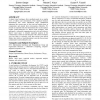Free Online Productivity Tools
i2Speak
i2Symbol
i2OCR
iTex2Img
iWeb2Print
iWeb2Shot
i2Type
iPdf2Split
iPdf2Merge
i2Bopomofo
i2Arabic
i2Style
i2Image
i2PDF
iLatex2Rtf
Sci2ools
CSCW
2004
ACM
2004
ACM
Action as language in a shared visual space
A shared visual workspace allows multiple people to see similar views of objects and environments. Prior empirical literature demonstrates that visual information helps collaborators understand the current state of their task and enables them to communicate and ground their conversations efficiently. We present an empirical study that demonstrates how action replaces explicit verbal instruction in a shared visual workspace. Pairs performed a referential communication task with and without a shared visual space. A detailed sequential analysis of the communicative content reveals that pairs with a shared workspace were less likely to explicitly verify their actions with speech. Rather, they relied on visual information to provide the necessary communicative and coordinative cues. Categories and Subject Descriptors H.5.3 [Information Interfaces and Presentation]: Group and Organization Interfaces – collaborative computing, computersupported cooperative work. General Terms Design, Exper...
| Added | 30 Jun 2010 |
| Updated | 30 Jun 2010 |
| Type | Conference |
| Year | 2004 |
| Where | CSCW |
| Authors | Darren Gergle, Robert E. Kraut, Susan R. Fussell |
Comments (0)

